How to enjoy the Sagano Scenic Train through the spectacular scenery of Kyoto even more! A journey to enjoy the stories

The Sagano Scenic Train is a must-see tourist train for sightseeing in Arashiyama, Kyoto. In fact, this trolley train has a little-known history, a "story." In this article, we will introduce a train trip using an audio guide that will reveal the hidden charms of the Sagano Scenic Train.
-
Table of Contents
- A journey to discover the "story" of the Sagano Scenic Train
- How to get to the Sagano Scenic Train
- Torokko Saga Station, which adds excitement to your train journey
- Discover new stories with your own personal guide
- During the break before departure, prepare yourself for the trolley train with the audio guide
- Would Kyoto not have existed without Hozukyo?
- The twists and turns of the trolley train's journey come to life
- A new train journey that lets you feel the history of the trolley train
A journey to discover the "story" of the Sagano Scenic Train
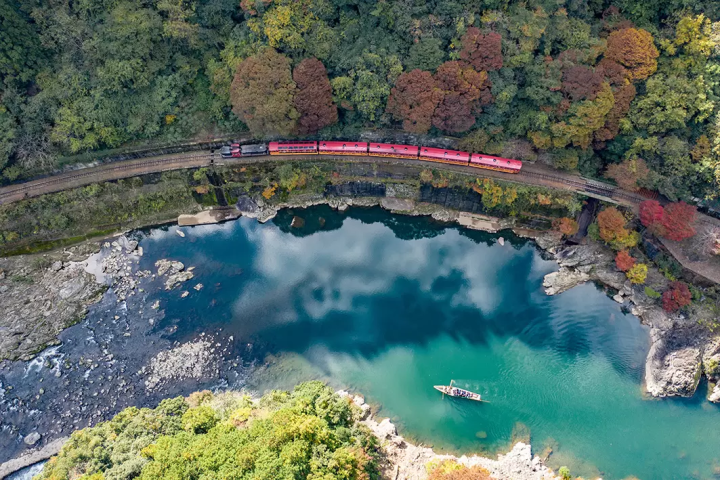
The Sagano Torokko Train runs for a total length of 7.3 km, connecting Saga Torokko Station and Kameoka Torokko Station .
The ride rocks and sways slowly for about 25 minutes, at a speed similar to that of a brisk bicycle.
From the open, glass-free windows, you can enjoy beautiful seasonal scenery unique to Japan, including cherry blossoms, green leaves, autumn foliage, and snowscapes.
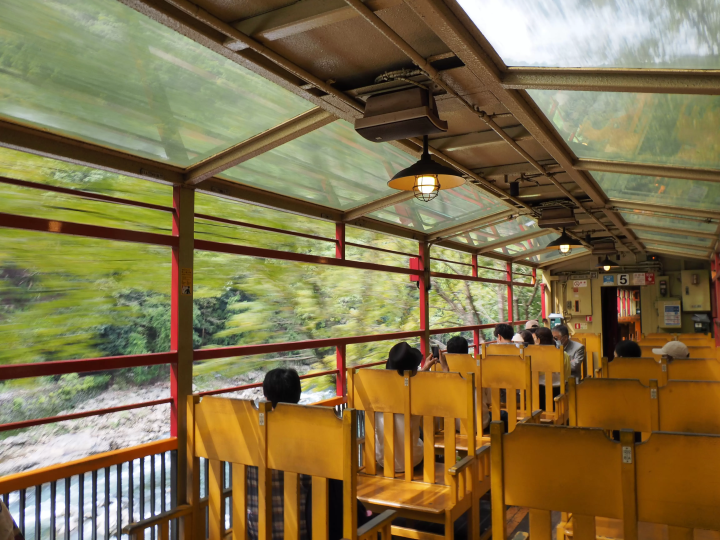
This extremely popular tourist railway offers a one-of-a-kind experience: boarding a retro train, receiving warm hospitality from the station staff, and enjoying the beautiful natural scenery.
However, what if there was a lot of twists and turns in the history of this tourist train before it was born? And what if, without this trolley train, Kyoto's history as a capital city might never have begun?
Through the audio guide, we will unravel the history of the Sagano Scenic Train, which you would not be able to see just by riding it .
How to get to the Sagano Scenic Train
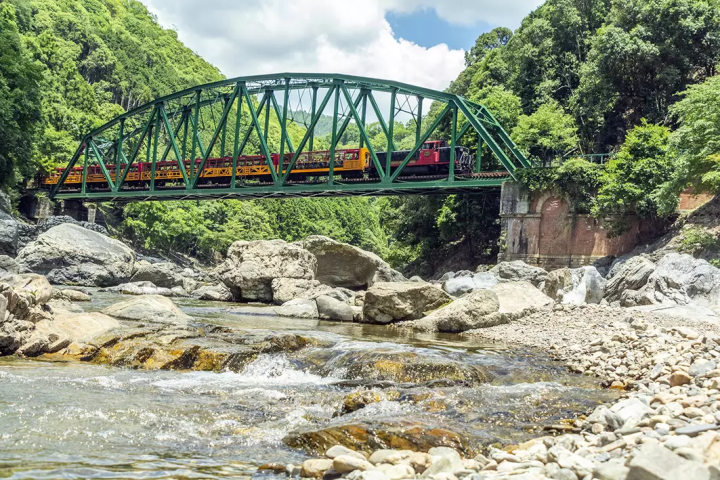
We recommend departing from JR Kyoto Station for the Sagano Scenic Train . You can get there without having to transfer , so there's no need to worry about getting lost.
From JR Kyoto Station
JR Sagano Line Platforms 31-33 JR Sanin Main Line (Sagano Line)
From "Kyoto Station", take the train for about 17 minutes (7 stops), get off at "JR Saga-Arashiyama Station", and exit immediately from the south exit.
How to get there from Kyoto city
If you are already staying in Kyoto, or are heading from central Kyoto, it will be easier to access the area if you return to Kyoto Station before departing .
[Central Kyoto: Shijo area, etc.]
About 3 minutes (2 stations) from Shijo Station on the Kyoto Municipal Subway Karasuma Line, get off at Kyoto Station → Transfer to the JR Line
JR Sagano Line, Platforms 31-33 JR Sanin Main Line (Sagano Line)
From "Kyoto Station", take the train for about 17 minutes (7 stops), get off at "JR Saga-Arashiyama Station", and exit immediately from the south exit.
How to get there by streetcar: Keifuku Electric Railroad Arashiyama Main Line "Arashiden"
To make your train trip even more exciting, we recommend taking the Arashiyama Tram, the only tram in Kyoto . You can have fun walking around the Arashiyama area on your way to the trolley railway.
[From central Kyoto: Shijo-Omiya by Arashiyama train]
Take the Keifuku Electric Railroad from Shijo-Omiya Station , ride for about 25 minutes (12 stations), get off at Arashiyama Station, and walk for about 13 minutes
Torokko Saga Station, which adds excitement to your train journey
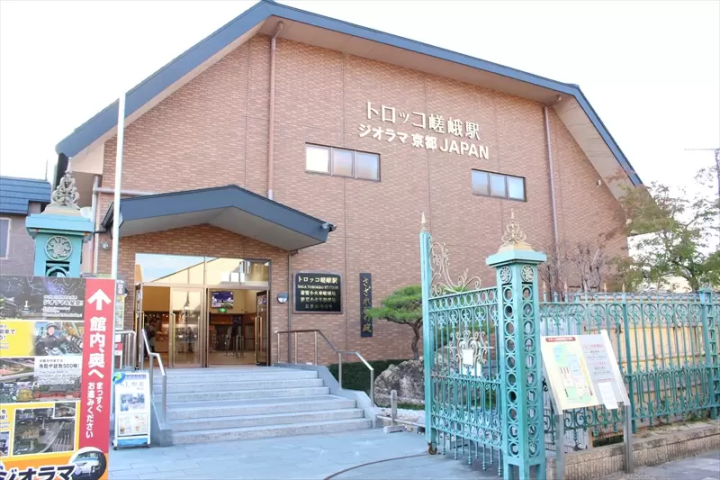
Once you arrive at JR Saga-Arashiyama Station and go down the stairs, you will immediately see a large brick station building. This is Torokko Saga Station, the starting and ending station for the trolley train.
The station building has high ceilings and is spacious, with plenty of corners that will make your time while waiting for the train more enjoyable.
This is a space that train lovers will love, with a shop where you can purchase original Sagano Torokko Train goods and Kyoto souvenirs, a cafe space where you can relax while waiting , the largest Kyoto diorama in western Japan, "Diorama Kyoto JAPAN," and even the "19th Century Hall" where you can see a real steam locomotive and rare musical instruments .
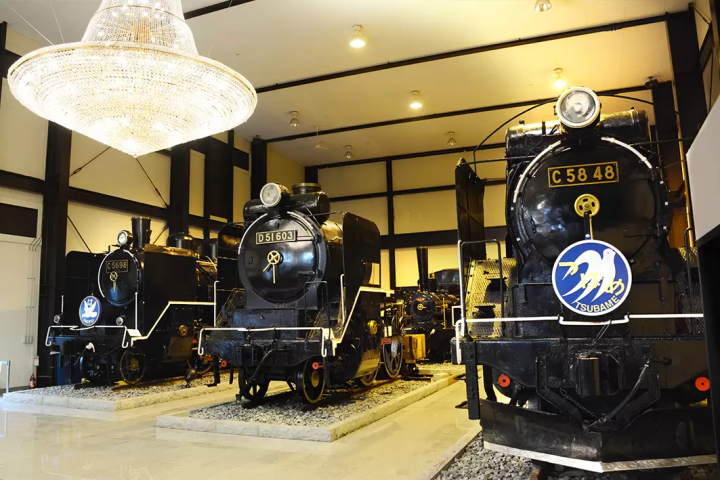
The world-famous grand piano and pipe organ located near the steam locomotive can be played by reservation , so if you time it right you might be able to hear their beautiful sounds.
There is so much to see that the short time before departure will not be enough, so we recommend leaving with plenty of time to spare .
Discover new stories with your own personal guide
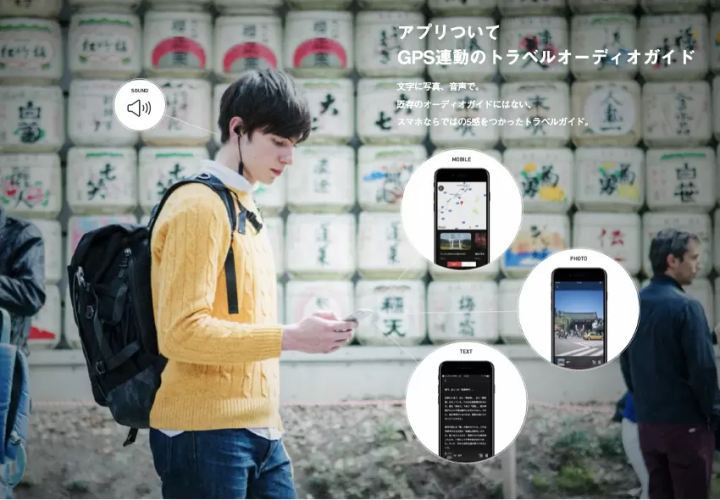
Once you've enjoyed your tour around Saga Torokko Station, download the audio guide app " ON THE TRIP" right away!
To fully enjoy the trolley railway, we recommend downloading the app before boarding the trolley railway .
The audio guide app ON THE TRIP is based on the theme of " turning every travel destination into a museum ," and covers cultural assets such as shrines and temples, stunning scenery, hot springs, art festivals, and even cultures such as Zen and sushi. It is a travel guide app that lets you explore things that interest you at various travel destinations on the spot.
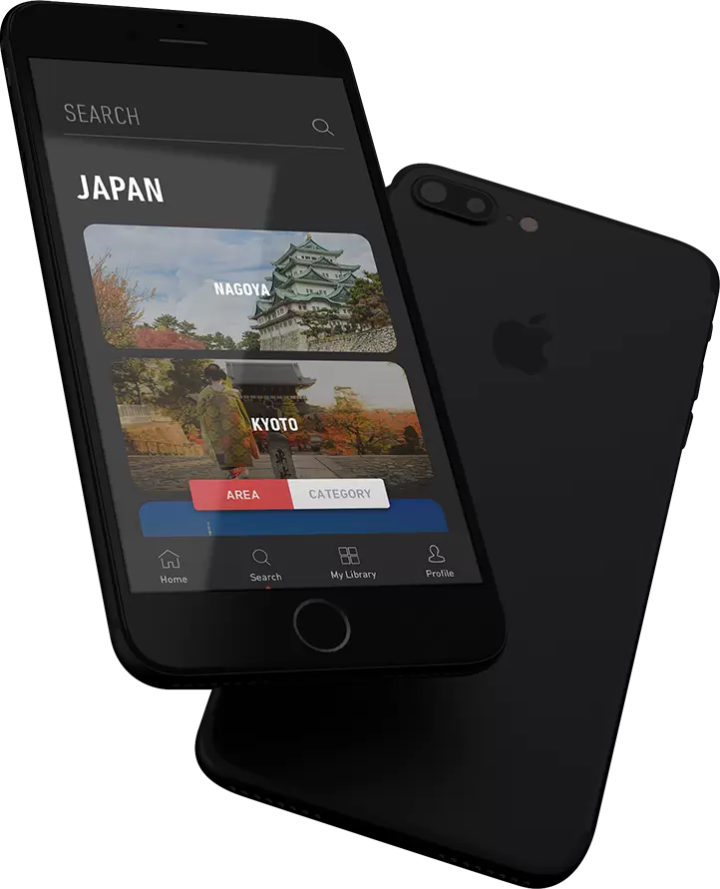
The audio guide is easy to use . Just download the ON THE TRIP app, launch it , and select the spot guide.
When you select a spot that interests you and play it , it will tell you about the history and background of the scenery in front of you with audio, text, and photos. *There are two types of guide playback: a GPS-compatible automatic playback type and a manual playback type.
During the break before departure, prepare yourself for the trolley train with the audio guide
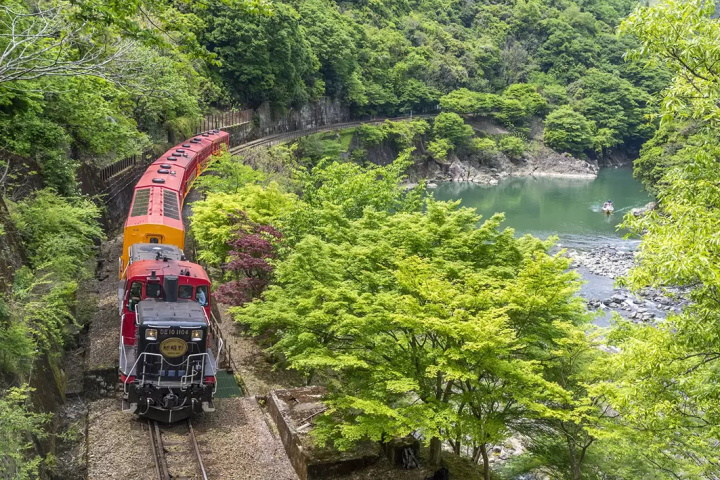
Once you launch the ON THE TRIP app, select " Sagano Scenic Railway ", which we will introduce in this article.
There are two guides for the trolley train: "Torokko Saga Station → Torokko Kameoka Station" and "Torokko Kameoka Station → Saga Station." The content of the guide itself is almost the same, but since the guide is automatically played in response to GPS, you can choose the guide at the departure station .
Since the train runs through the mountains, we recommend downloading the guide onto your smartphone so you won't be affected by signal conditions .
ON THE TRIP audio guides can be listened to anytime, anywhere by connecting to the Internet or downloading them to your device, even if you are not at the location.
If you have time before your train departs, it might be a good idea to do a little preparation beforehand.
The trolley train is entertainment that can be enjoyed by engaging all five senses , with its unique sound, the retro carriages that make you excited just by riding them, the beautiful scenery of Hozukyo Gorge, and the uplifting hospitality of the conductors.
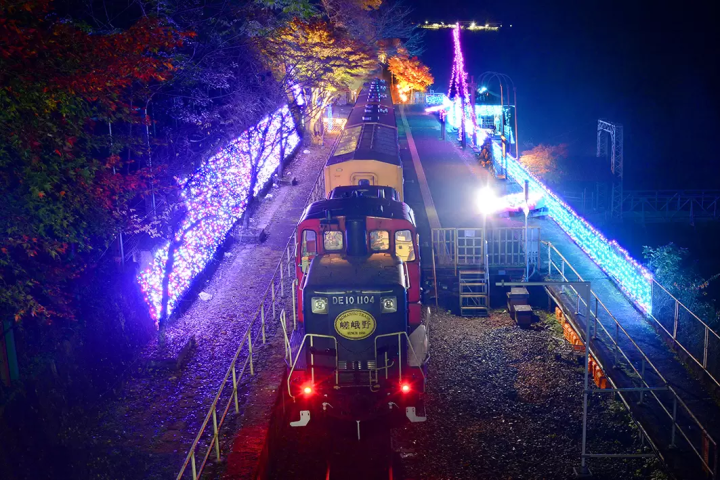
To avoid accidentally missing important points while the train is moving, it's a good idea to get a little background information before boarding the train.
However, if you'd like to cherish the experience of experiencing it for the first time, just download the audio guide so you can listen to it immediately and imagine the story of the trolley train as you go.
Tips for enjoying the trolley train using an audio guide
1. Prepare before you leave
- The audio guide can be listened to anytime, anywhere, not just on the trolley train. To make sure you don't miss anything during your ride, we recommend listening to it before arriving at Sagano Torokko Station.
② Listen on the return train
- If you are taking the trolley train round trip and want to enjoy a new experience, listen to the guide on the return train. You will discover new things that you could not see on the outbound train.
3. Review after getting off the train
- If you listen to the guide after you get off the trolley train, you'll discover something new that you didn't notice when you first got off. Just as you're enjoying the afterglow of your trip before returning to your daily life, be sure to listen to the guide on your way home. You can enjoy the guide at any time, even if you're far away.
Would Kyoto not have existed without Hozukyo?
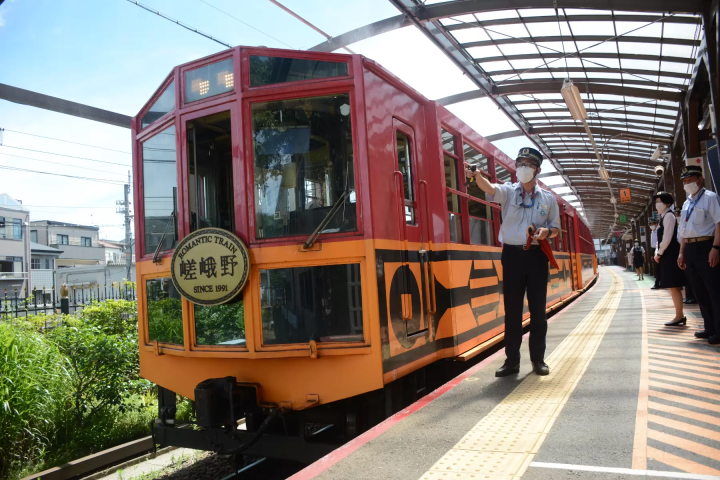
Once you've got your audio guide ready, it's time to board the train!
The interior of the train is cute and retro, with red window frames, umbrella-shaped light bulbs, and nostalgic wooden chairs.
Before the departure signal is given, insert an audio guide earphone into one ear . Please leave the other earbud open and enjoy the conductor's guidance.
In my personal experience, I felt that I could hear the conductor's voice more clearly if I put the earphones in the ear by the window. However, this may vary from person to person, so please try them out when you are there to see which earphones are easier to hear.
While enjoying the refreshing breeze through the open windows and being rocked to the loud rumbling of the train, the guide's audio started playing automatically.
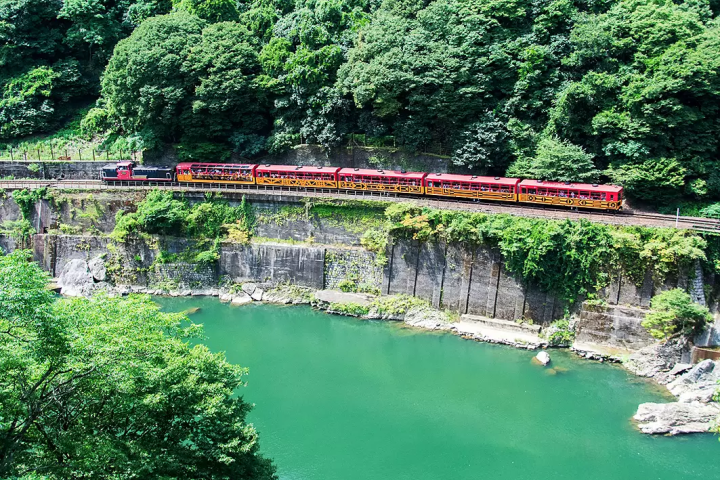
――――――――――――――――――――――
02: Torokko Arashiyama Station to Torokko Hozukyo Station "Without Hozukyo, would Kyoto have existed?"
(Omitted)
After the capital was moved to Kyoto, the Hozu River began to carry even more timber than before. The cut trees were made into logs and assembled into rafts. People would climb on top of these logs and row down the Hozu River in a life-risking rafting adventure .
Imagine this. The rafters rowing through the rapids, sometimes battling against the raging river. This is how timber was transported and the capital of Kyoto was built. And Emperor Saga, the origin of Sagano, ascended to the throne.
Long before the trolley trains began running, the Hozu River was an important cargo transporting timber . Not only for the capital, but also for the many temples and people living in Kyoto , the city developed with the Hozu River as its energy source.
――――――――――――――――――――――
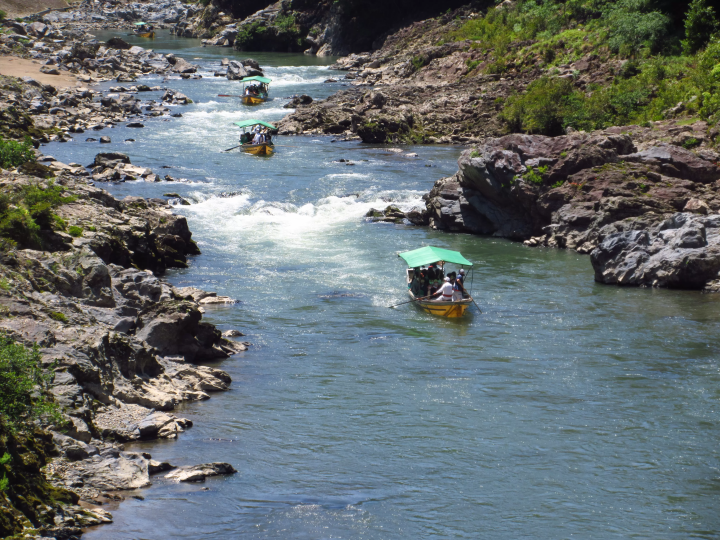
In an era when there were no life jackets, our ancestors would ride down the river on cut logs. Without the hardships and wisdom of the people of the past who coexisted with nature and made use of its blessings, Kyoto may not have become the tourist city it is today. We must not forget that life-risking river boating has become a tourist activity in modern times and continues to do so.
As I imagine the life-risking boat rides that took place on the beautiful river in front of us, the train continues to rumble and meander towards Kameoka Torokko Station.
The twists and turns of the trolley train's journey come to life
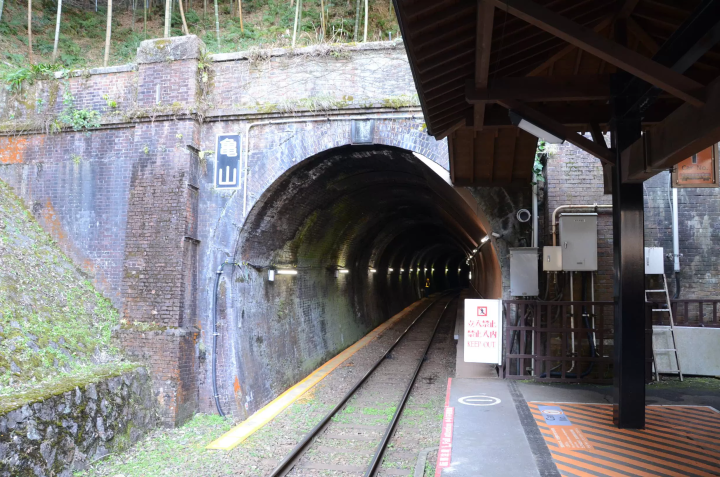
How did people back then build a railway in this location, with its winding tracks that run along the Hozu River, its many tunnels, and its sheer cliffs?
Just as the tunnel came into view for the umpteenth time, the next guide came on.
――――――――――――――――――――――
03: Torokko Hozukyo Station to Torokko Kameoka Station "What are the challenges of running a railway on a steep cliff?"
It was the Meiji era. A certain politician planned to build a railway linking Kyoto with Maizuru, a port on the Sea of Japan. However, with the technology available at the time, it was a huge challenge to build a railway while digging tunnels through the mountains and building bridges over rivers. Transporting construction materials to the steep valleys was also a struggle. The biggest obstacle was Hozukyo Gorge, where the train currently runs .
Without modern heavy machinery, they used hoes and shovels to complete eight tunnels and 51 bridges, mostly by hand. This included the longest iron bridge in Japan at the time. These constructions required huge amounts of money, and plans to connect to Maizuru were abandoned. Nevertheless, they managed to complete the railway that ran from Kameoka to Sonobe.
――――――――――――――――――――――
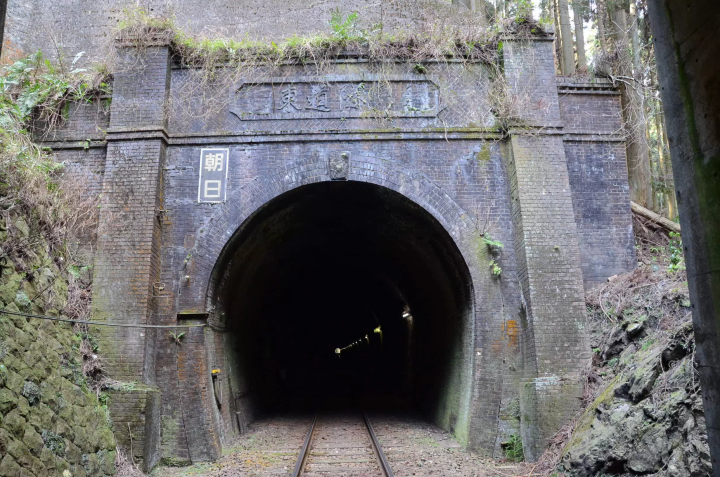
Eight tunnels dug by hand, and 51 bridges. While you are amazed at the unimaginable labor involved, the story of the romanticism that our predecessors had for trains overlaps with the beautiful scenery before your eyes.
Perhaps the driving force behind my decision to forge ahead on a pathless road was the captivating scenery of Hozukyo Gorge.
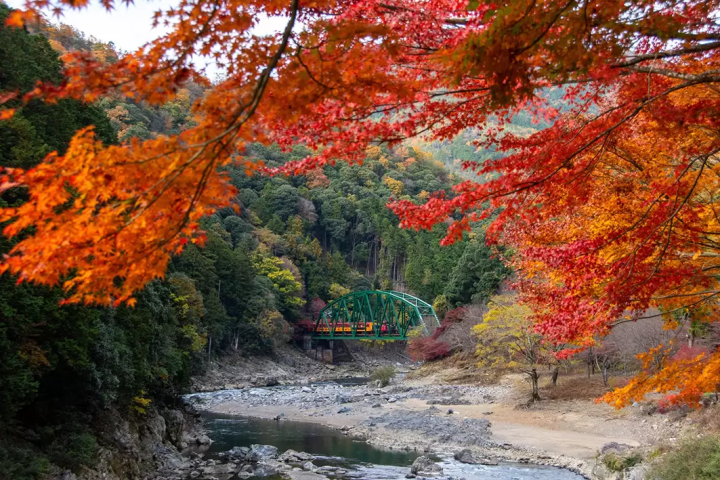
As I recalled the conductor's announcements and the happy expressions of the staff as the train departed, I felt that the passion of the people who have lived and walked in harmony with nature is still passed down even now that the train has become a tourist train.
Be sure to listen for yourself to the story of how the train evolved from a freight car to the Sagano Scenic Train after the track was opened.
A new train journey that lets you feel the history of the trolley train
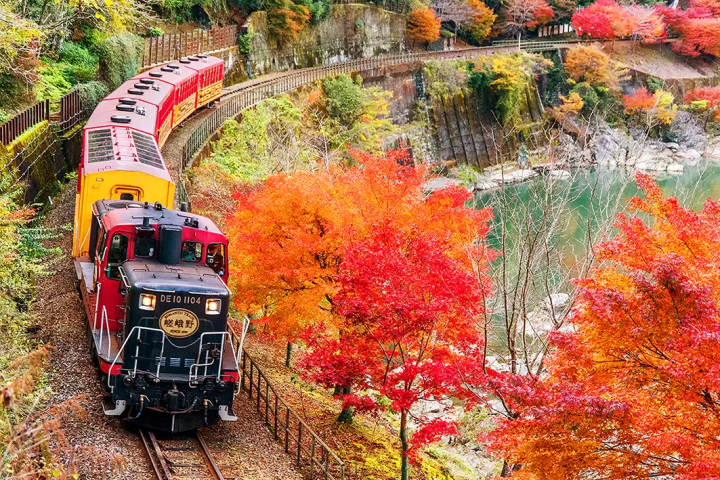
By learning about the history of the trolley train, the Hozu River, and the Hozu Gorge, I was able to learn about the thoughts and history of our ancestors that have been passed down through the generations. Even if you don't know the history, I'm sure a trip on the trolley train is a wonderful experience where you can encounter warm hospitality and beautiful scenery.
However, knowing the " story " of the land allows you to see certain scenery and feel even more affectionate towards the land.
Why not experience a journey on the Sagano Scenic Train that only you can discover?
ON THE TRIP is an audio guide app that lets you enjoy cultural assets such as temples, shrines, and art museums, as well as the stories that live in each city, all while touring spots mapped out on a map. Each guide is a moving work of art, like a movie or novel, and listening to it will deepen your understanding of your destination and enhance your travel experience. We'll introduce you to the charms of Japan that you won't find in guidebooks, revealed through the audio guide app, and a new way of traveling that can only be experienced with an audio guide.
The contents on this page may partially contain automatic translation.



























![[2026] Top 5 Strawberry Picking Spots in Tokushima, Naruto| Farms and Access Guide for January to May](https://resources.matcha-jp.com/resize/720x2000/2025/03/06-227165.webp)



